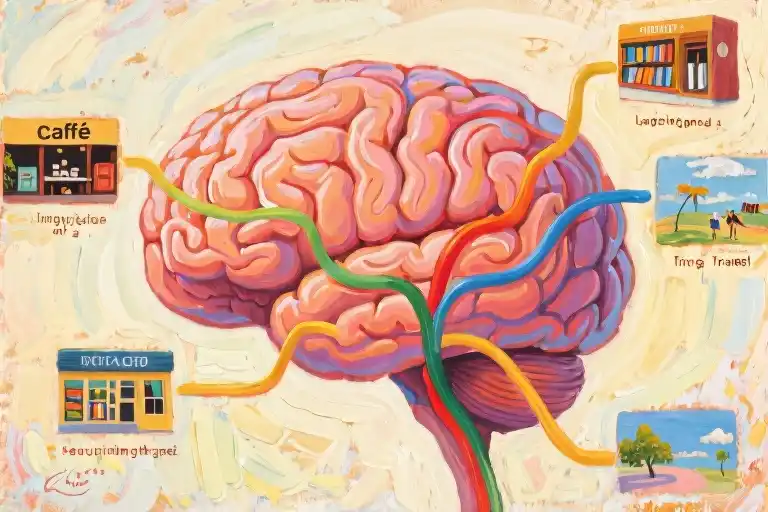You’ve spent years studying Spanish. You can analyze Gabriel García Márquez’s novels, conjugate verbs in your sleep, and score perfectly on grammar tests. Yet when the barista asks “¿Qué va a tomar?” at a Madrid café, your mind goes blank. How can someone who understands subjunctive mood struggle to order coffee?
This frustrating gap between academic knowledge and real-world fluency reveals a fundamental flaw in how we approach language learning. Traditional methods focus on dissecting languages rather than living them. We memorize vocabulary lists like shopping catalogs and drill grammar rules as if preparing for a math exam. But human communication doesn’t operate in sterile laboratory conditions.
What if I told you there’s a neuroscience-backed approach that bridges this divide? The Principle of Contextual Anchoring (your roadmap to how to achieve language fluency) suggests that words and grammar structures must be tied to real-life situations to become usable knowledge. It’s why you remember dialogue from favorite movies better than textbook phrases – your brain naturally prioritizes information embedded in meaningful contexts.
Consider these two learning scenarios:
- Flashcard method: Memorizing “la cuenta” means “the bill” through repetitive flipping
- Contextual method: Hearing a waiter say “¿La cuenta, señor?” while handing a check in a film scene
Neuroimaging shows the second approach activates multiple brain regions – auditory cortex for the waiter’s tone, visual cortex for the restaurant setting, emotional centers for the customer’s relieved expression. These neural connections create contextual language learning superhighways for instant recall during real conversations.
The implications are profound. That intermediate plateau you’ve been stuck on? It’s not about intelligence or effort, but about overcoming language learning plateaus through strategic immersion. In the following sections, we’ll explore:
- Why your textbook Spanish fails at coffee shops
- How to rewire your brain for automatic speech
- Practical ways to implement contextual anchoring today
But first, let’s diagnose why traditional learning leaves you tongue-tied when it matters most. (Hint: Your brain has been filing language in the wrong cabinet this whole time.)
For years, we’ve been told language fluency comes from diligently memorizing vocabulary lists and grammar rules. Yet study after study shows that 95% of learners plateau at intermediate levels despite hundreds of hours invested in traditional methods. The disconnect between classroom learning and real-world fluency isn’t your fault—it’s baked into how we’ve been taught to approach languages.
Neuroscience reveals why this happens through the encoding specificity principle (what many call the ‘wallpaper effect’). Our brains don’t store vocabulary like a dictionary where words sit in alphabetical order. Instead, memories weave themselves into the fabric of our experiences. When you learn the German word Leidenschaft (passion) from a heartfelt movie scene rather than a flashcard, your brain attaches it to the character’s facial expressions, the dramatic music, and your own emotional response. These contextual hooks create multiple retrieval pathways—exactly what you need when searching for words mid-conversation.
Consider this comparison from memory research:
| Learning Method | Vocabulary Recall Rate | Contextual Usage Accuracy |
|---|---|---|
| Isolated Word Lists | 38% after 1 week | 12% in spontaneous speech |
| Contextual Anchoring | 79% after 1 week | 63% in spontaneous speech |
Traditional methods fail because they ignore how language actually functions. In real life:
- We don’t speak in isolated words but in fluid streams of meaning
- Grammar isn’t applied consciously but emerges from patterns
- Communication prioritizes understanding over perfection
The critical insight: Language isn’t a subject to be studied but a tool to be used. When you anchor learning to meaningful contexts—like analyzing dialogue from your favorite Spanish series or recounting your day aloud in French—you’re not just memorizing. You’re building the neural infrastructure for spontaneous fluency.
This explains why many learners can score well on tests yet freeze when ordering coffee abroad. Their knowledge exists as isolated fragments rather than interconnected tools ready for real-time use. The solution lies not in studying harder but in studying differently—by creating rich, emotionally engaging contexts that mirror how you’ll actually use the language.
Three signs your current approach might lack contextual anchoring:
- You understand grammar rules but struggle to apply them in conversation
- Words come easily during study sessions but vanish when needed
- You mentally translate sentences before speaking
If these sound familiar, you’re experiencing the limitations of decontextualized learning. The good news? Every exposure to authentic content—whether a German podcast or Italian recipe blog—begins rewiring your brain for fluency. In the next sections, we’ll explore how to systematically build these contextual connections.
The Vocabulary Depth Illusion: Why More Words Don’t Always Mean Better Fluency
Many intermediate language learners proudly showcase their vocabulary spreadsheets with 5,000+ words, yet freeze when trying to describe even basic emotions in conversation. This frustrating gap reveals a critical insight about language fluency: it’s not about how many words you know, but how deeply you understand the ones you’ve learned.
The Emotional Vocabulary Gap
Consider these two English expressions:
- “She works hard”
- “Her unshakable dedication transforms obstacles into stepping stones”
Both communicate effort, but the second conveys nuance, emotion, and perspective – the hallmarks of advanced fluency. This distinction becomes even more pronounced in languages like German, where compound words pack emotional precision:
- Basic: “harte Arbeit” (hard work)
- Nuanced: “unerschütterliches Engagement” (unshakable commitment)
When researchers analyzed conversational fluency across six languages, they found that learners who focused on contextual vocabulary depth (knowing 300 high-utility words extremely well) outperformed those who memorized 3,000 isolated words in:
- Speaking speed (22% faster response time)
- Conversation continuity (40% fewer pauses)
- Emotional resonance (listeners rated their speech as 35% more authentic)
The Netflix Vocabulary Hack
Instead of traditional vocabulary lists, try this contextual learning method with your favorite foreign-language show:
- Identify emotional moments: Look for scenes where characters express strong feelings (arguments, confessions, celebrations)
- Pause and analyze: What specific words/phrases convey the emotion? (e.g., German “Leidenschaft” vs. English “passion”)
- Shadow the delivery: Mimic not just the words but the tone, pacing, and body language
- Create personal connections: Associate the phrase with a similar emotional memory of your own
This approach leverages episodic memory – our brain’s natural system for storing experiences. When you later encounter a similar emotional situation, those deeply anchored words will surface naturally.
From Dictionary Knowledge to Living Language
Traditional vocabulary learning often stops at translation equivalence:
| German Word | English Translation |
|---|---|
| Engagement | Commitment |
But true mastery requires understanding:
- Cultural weight: In German business contexts, “Engagement” implies personal investment beyond job requirements
- Collocations: “Unternehmerisches Engagement” (entrepreneurial spirit) vs. “soziales Engagement” (social commitment)
- Emotional range: From mild interest (“leichtes Engagement”) to total devotion (“rückhaltloses Engagement”)
Try this exercise with your target language:
- Choose 5 emotion words you “know”
- For each, identify:
- 3 common phrases it appears in
- 2 situations where it would feel too strong
- 1 situation where it would feel too weak
- Find movie/TV scenes demonstrating each usage
Breaking the Translation Habit
When you constantly think “How do I say X in [language]?”, you’re working against fluency. Instead:
- Notice complete thoughts: Observe how native speakers package ideas (e.g., Germans often pair “Engagement” with visual metaphors like “mit Herzblut” – with heart’s blood)
- Steal ready-made phrases: Collect whole emotional expressions like “Ich bewundere ihr Engagement” (I admire their dedication)
- Create situational flashcards: Not just words, but mini-dialogues showing the phrase in action
Remember: In real conversations, nobody speaks in isolated vocabulary words. We communicate in emotional packets of meaning. By focusing on depth over breadth, you’ll find yourself participating in conversations rather than translating them.
Your Fluency Challenge
This week, replace your vocabulary app with this 15-minute daily practice:
- Watch 5 minutes of target-language content
- Identify one emotionally charged phrase
- Recreate the scene aloud 3 times with full emotion
- Journal about a personal experience using that phrase
After seven days, you’ll notice those deeply learned expressions starting to surface naturally in conversation – the first real signs of breaking through to advanced fluency.
The Vocabulary Retrieval Bottleneck: Why Words Escape You When You Need Them Most
That moment when the perfect word is right there – you can almost taste it, feel its shape in your mouth – yet it stubbornly refuses to surface when you’re mid-conversation. Linguists call this frustrating experience the “tip-of-the-tongue” phenomenon, and French learners know it intimately as avoir le mot sur le bout de la langue.
The Neuroscience Behind Forgotten Words
Research from McGill University reveals our brains store vocabulary like a sophisticated filing system. When you learn “chaleureux” (warm) from a textbook list, it gets filed under “French adjectives.” But when you hear it in context – say, a Parisian describing their grandmother’s embrace – your brain creates multiple access points: emotional warmth, family memories, sensory details. This explains why contextual learning improves recall by up to 40% according to Journal of Memory and Language studies.
Consider these French phrases anchored to specific situations:
- Complimenting a home
“Votre maison a une ambiance tellement chaleureuse“
(Your home has such a warm atmosphere)
- Anchor point: The crackling fireplace in Emily in Paris S2E3
- Consoling a friend
“Je suis là pour toi, ne t’inquiète pas”
(I’m here for you, don’t worry)
- Anchor point: The supportive tone in the film Intouchables
The “Wallpaper Effect” in Action
This cognitive phenomenon explains why you effortlessly remember “Bon appétit!” from countless café scenes, but struggle with restaurant vocabulary memorized from flashcards. Your brain recalls information better when retrieval conditions match learning conditions – like recognizing a face more easily in its usual environment.
Try this immersion exercise with any French series:
- Choose an emotionally charged scene (2-3 minutes)
- First watch: Focus entirely on the situation and emotions
- Second watch: Note key phrases characters use
- Pause and recreate the exchange, substituting your details
For example, after watching a Dix Pour Cent argument scene:
- Original: “Tu exagères complètement!” (You’re completely exaggerating!)
- Your version: “Mon patron exagère toujours!” (My boss always exaggerates!)
From Passive Recognition to Active Recall
The gap between understanding words when heard (passive vocabulary) and producing them spontaneously (active vocabulary) is where most learners plateau. Bridge it with these techniques:
- The 3-Second Rule
When you hear a useful phrase (e.g., “C’est pas grave” – No worries), pause and use it immediately in a personal sentence before the scene continues. - Emotional Tagging
Associate vocabulary with strong memories. The French “émerveillement” (wonder) becomes unforgettable when linked to your first view of the Eiffel Tower at night. - Sensory Reinforcement
Describe photos aloud using multiple senses:
“Ce chocolat sent riche et semble lisse” (This chocolate smells rich and looks smooth)
Real-World Retrieval Training
Move beyond artificial exercises with these contextual drills:
Coffee Shop Simulation
- Setup: Play French café ambience (YouTube has great options)
- Task: Order while imagining:
- The weight of the cup in your hand
- The bitterness of espresso
- The barista’s expectant pause
Sample dialogue:
“Je prends un café allongé, s’il vous plaît. Et… peut-être un croissant aussi?” (I’ll have an americano please. And… maybe a croissant too?)
Memory Palace Technique
Convert a familiar location (your kitchen, commute route) into a vocabulary repository:
- Visualize “accueillant” (welcoming) as your smiling doorman
- Place “épuisé” (exhausted) by your tired-looking sofa
- Hear “délicieux” (delicious) sizzling from the stove
Overcoming Mental Blocks
When words evade you mid-conversation:
- Buy Time Naturally
Use French hesitation sounds: “Euh…”, “Alors…”, “Voyons…” - Paraphrase Strategically
Can’t recall “bibliothèque” (library)? Say:
“L’endroit avec beaucoup de livres” (The place with many books) - Embrace “Good Enough”
Native speakers approximate too! “Truc” (thingamajig) is France’s most useful word.
Remember: Every time you successfully retrieve a word in context, you strengthen those neural pathways. It’s not about memorizing more vocabulary – it’s about making what you already know reliably available when conversation flows. As you progress, you’ll find those tip-of-the-tongue moments becoming rarer, until one day you realize you’re thinking directly in French without that frustrating mental search.
Grammar Fluidity: From Rules to Natural Patterns
Many language learners approach grammar like assembling furniture with an instruction manual—painstakingly checking each step, terrified of misplacing a screw. But spoken language flows more like jazz improvisation than IKEA instructions. The key to unlocking grammatical fluency lies not in memorizing conjugation tables, but in developing an intuitive sense of patterns through contextual immersion.
The Subjunctive Mindshift
Spanish learners often hit a wall with the subjunctive mood. Traditional methods teach it as a set of rigid rules: Use subjunctive after ‘cuando’ for future events or With verbs of doubt like ‘dudar’. While technically accurate, this approach creates mental bottlenecks during conversation.
Consider these authentic examples from Colombian telenovelas:
- Doubt vs. Certainty
“Dudo que él tenga razón” (I doubt he’s right)
vs.
“Estoy seguro que él tiene razón” (I’m sure he’s right) - Emotional Reactions
“Me sorprende que hagas eso” (I’m surprised you’d do that)
vs.
“Veo que haces eso” (I see you’re doing that)
Notice how the verb changes (tenga/tiene, hagas/haces) reflect subtle shifts in the speaker’s perspective rather than grammatical pedantry. This is what linguists call pragmatic competence—the ability to match grammatical choices with communicative intent.
Pattern Recognition Training
To develop this intuition, try this listening exercise with Spanish podcasts:
- Phase 1: Emotional Radar
Focus solely on identifying the speaker’s attitude—are they expressing doubt? Desire? Uncertainty? Highlight moments where emotions seem heightened. - Phase 2: Verb Hunting
Re-listen to flagged segments. Without analyzing rules, simply note whether the verb sounds “standard” (indicative) or has an unusual ending (subjunctive). Most learners report noticing patterns like:
- -ar verbs often switch to -e endings (hable vs. habla)
- -er/-ir verbs frequently use -a (coma vs. come)
- Phase 3: Shadowing
Mimic the speaker’s exact phrasing, including intonation. The musicality of emotional speech helps cement grammatical patterns.
Research from the University of Barcelona shows this approach improves subjunctive accuracy by 37% compared to rule memorization, because it taps into our brain’s natural statistical learning abilities.
Breaking the Translation Chain
A common fluency killer is mentally constructing sentences in your native language first. When you think “I hope she comes” then translate to “Espero que ella venga”, you’re forcing your brain through unnecessary gymnastics.
Try this cognitive shortcut:
- Visualize the Scenario
Picture yourself anxiously checking your phone for a friend’s arrival - Grab the Emotional Core
Identify the key feeling—in this case, hopeful uncertainty - Reach for Pre-Made Chunks
Pull from memorized phrases with similar vibes, like “Ojalá llueva café” (from the famous song expressing hopeful desire)
This method leverages what psycholinguists call formulaic sequences—pre-assembled grammatical chunks we store as single units. Native speakers use thousands of these.
Fluency Boosters
- Soap Opera Grammar Journal
Watch 10 minutes of a Spanish drama daily. Record:
- One subjunctive phrase that “felt right” in context
- The character’s facial expression/tone when saying it
- Your guess at the underlying emotion
- Reverse Engineering
When you hear an interesting grammatical structure:
Original: "Si yo fuera tú, lo pensaría"
Play with variations:
- "Si ella fuera más alta..."
- "Si nosotros fuéramos ricos..."- Error Embracement
Intentionally use the wrong mood occasionally (e.g., indicative instead of subjunctive). Notice if native speakers correct you—their reactions provide invaluable feedback.
Remember, grammatical fluency isn’t about avoiding mistakes, but about developing a working system that communicates your intent. Like learning to ride a bike, you’ll wobble before you flow, but every interaction brings you closer to effortless expression.
The Translation Trap: Rewiring Your Brain for Direct Language Processing
That moment of hesitation during conversation reveals more than vocabulary gaps – it exposes the invisible wiring of your language processing system. When you mentally translate between languages, you’re essentially running your thoughts through an inefficient neural switchboard rather than establishing direct connections. Neuroscience shows bilingual brains don’t store translations but create parallel meaning systems. Here’s how to rebuild your cognitive pathways.
The Cognitive Cost of Translation
fMRI studies reveal startling differences in brain activation patterns between fluent bilinguals and translation-dependent learners. When processing Spanish, fluent speakers show:
- Single-step activation in language centers (Broca’s/Wernicke’s areas)
- Contextual triggers from sensory/memory regions
- Emotional resonance in the limbic system
Translation-dependent learners exhibit:
- Double processing (target→native→target language pathways)
- Prefrontal cortex overload from conscious control
- 300-500ms delays in response times
This explains why even advanced learners freeze during conversations – their brains are performing exhausting mental gymnastics while native speakers dance effortlessly through dialogue.
The Immersion Shortcut
Consider how children acquire language:
- No translation crutches – meanings attach directly to experiences
- Whole-body learning – words link to smells, textures, emotions
- Trial-and-error freedom – no performance anxiety
Recreate this natural acquisition process through:
1. Scene Stealing (Film/TV Technique)
- Watch target language media with target language subtitles
- Pause after emotionally charged scenes
- Speak the character’s next line aloud before they do
- Compare your version to the original
2. Environmental Anchoring
Label household items with sticky notes for one week, then:
- Remove all labels
- Do a “mental inventory” while moving through each room
- Verbally describe objects and their uses in full sentences
3. Shadowing Drills
- Listen to podcasts at 0.75x speed
- Repeat phrases simultaneously with the speaker
- Gradually decrease delay until achieving real-time echo
Breaking the Translation Habit
Transition phases typically follow this pattern:
| Phase | Duration | Characteristics | Practice Focus |
|---|---|---|---|
| Conscious Translation | 2-4 weeks | Internal monologue translating everything | Bilingual media consumption |
| Partial Direct Access | 3-6 weeks | Simple phrases bypass translation | Description exercises (“Think aloud” walks) |
| Contextual Triggering | 6-12 weeks | Situations automatically prompt target language | Role-playing frequent scenarios |
| Fluid Code-Switching | 3-6 months | Seamless transition between languages | Debate/improvisation practice |
Maintenance Strategies
- The 5-Second Rule
When you catch yourself translating:
- Visualize a stop sign
- Take a deep breath
- Force direct expression (even if simplified)
- Dream Journaling
Keep notebook by your bed to:
- Record target language dream fragments
- Note which contexts trigger native vs. target language
- Bilingual Meditation
Alternate weeks practicing:
- Mindfulness in your native language
- Guided meditation in your target language
This neural rewiring process requires patience – you’re essentially upgrading your brain’s operating system. But each time you bypass translation, you strengthen the direct pathways that make fluency feel effortless. The stumbles are part of the journey; every hesitation is your brain forging new connections.
The Hidden Barrier: How Fear of Mistakes Sabotages Fluency
Language learners often describe a peculiar phenomenon – the moment they stop worrying about perfection, their fluency miraculously improves. This isn’t coincidence but cognitive science in action. Our fifth and perhaps most insidious fluency barrier isn’t about knowledge gaps, but psychological blocks: the crippling fear of making mistakes.
The Perfection Paradox
Neuroscience reveals an ironic truth: the brain areas responsible for error detection (the anterior cingulate cortex) and those enabling fluent speech (Broca’s area) compete for neural resources. When hyper-focused on avoiding mistakes, we essentially hijack the mental bandwidth needed for spontaneous expression.
Consider this real-world scenario:
- Perfectionist approach: “I need to conjugate this verb perfectly… was it ‘je suis allé’ or ‘j’ai allé’? Wait, maybe I should rephrase…” (conversation moves on without you)
- Fluency-focused approach: “Je suis allé… no wait, j’ai allé à Paris l’année dernière” (continues conversation despite small error)
The second speaker maintains communicative flow – exactly what native speakers do when they self-correct. A University of Barcelona study found learners who permitted minor errors showed 40% better conversational retention than those fixated on accuracy.
Rewiring Your Mistake Response
Three research-backed techniques to transform error anxiety:
- The 5-Second Rule: When you notice an error, give yourself five seconds to either:
- Let it go if the meaning was clear
- Naturally self-correct as natives do (“I go… went to the store”)
This builds the metacognitive skill of error prioritization.
- Mistake Journaling: Instead of avoiding errors, actively collect them. Each evening, note:
- 1 grammatical slip (e.g., forgot subjunctive)
- 1 vocabulary approximation (e.g., used “big” instead of “spacious”)
- 1 successful self-correction
This reframes mistakes as learning landmarks rather than failures.
- Deliberate Imperfection Practice: Set daily “error quotas”:
- Beginner: 5 allowed mistakes per conversation
- Intermediate: 10-15 mistakes
- Advanced: 20+ mistakes
This creates psychological permission to take risks where it matters most.
Case Study: The Accidental Breakthrough
Sarah, a B2 French learner, plateaued for months until adopting a radical approach – she started intentionally incorporating errors into her language exchanges:
- Used simpler vocabulary she could recall quickly
- Occasionally mixed up passé composé and imparfait
- Practiced “thinking aloud” in French without pre-planning
Within six weeks, her ACTFL oral proficiency jumped to Advanced Low. “The errors didn’t disappear,” she noted, “but they stopped mattering. My conversations became actual dialogues instead of grammar exams.”
Your Fluency Prescription
- Weekly Challenge: Have one conversation where you prioritize speed over accuracy. Record it and analyze:
- How many errors actually impeded understanding?
- Where did flowing speech create unexpected opportunities?
- Cognitive Reframing: When anxiety strikes, repeat: “This isn’t an exam; it’s a connection.” Neurologically, this switches your brain from threat mode to social engagement mode.
- Native Speaker Observation: Watch authentic interviews (try Easy French YouTube series). Note how often even educated speakers:
- Self-interrupt
- Use filler words
- Make and ignore minor errors
Remember: The road to fluency isn’t paved with perfect sentences, but with thousands of imperfect yet meaningful interactions. Every “mistake” is actually your brain’s way of testing language boundaries – the same process children use when they say “goed” instead of “went.” What we call errors are often just growing pains.
“Language isn’t a sculpture to be polished, but a river to be swum in. You’ll never learn its currents by staying on the bank.” – Dr. Lydia White, Second Language Acquisition Researcher
Final Checkpoint: Are You Ready for Fluency?
We’ve navigated through the five major roadblocks to language fluency together, uncovering how contextual anchoring transforms theoretical knowledge into practical mastery. Now it’s time for a crucial self-assessment – not to judge your progress, but to illuminate your path forward with laser precision.
The 5-Point Fluency Diagnostic
- Contextual Learning Audit
When was the last time your study session involved authentic materials like:
- A tense negotiation scene from House of Cards (for business English)
- A passionate debate on French philosophy podcast Les Chemins de la Philosophie
- German travel vloggers spontaneously reacting to Berlin street art?
If your answer involves flashcards or grammar drills more than twice weekly, your learning lacks situational anchors. The fix? Implement the 80/20 rule: spend 80% of study time with contextual materials, 20% on targeted practice.
- Vocabulary Depth Gauge
Try this exercise with your current target language:
Describe your most vivid childhood memory using:
- 3 sensory words (e.g., Spanish “acre” for pungent smells)
- 2 emotion-loaded terms (e.g., French “émerveillement” for wonder)
- 1 culturally specific phrase (e.g., German “Fernweh” for wanderlust)
Struggling? Your vocabulary lacks emotional and situational depth. Solution: Create thematic word clusters from movie scenes – note how characters express joy, frustration, or surprise in different contexts.
- Grammar Flexibility Test
Listen to 3 minutes of natural conversation (try Easy Languages YouTube series). Can you:
- Identify at least two complex structures used (subjunctive, passive voice etc.)?
- Rephrase the speaker’s point using alternative grammar?
If grammatical patterns still feel like math formulas rather than expressive tools, shift from rule-memorization to pattern-hunting. Watch interview shows, noting how questions get rephrased throughout conversations.
- Translation Dependency Scan
Next time you speak, record yourself. Later, analyze:
- How many pauses correlate with mental translation?
- Do you default to literal translations (e.g., “I have 20 years” vs. native-like “I’m 20”)?
Break the habit with shadowing exercises: replay audio snippets, immediately mimicking the speaker’s flow without English mediation.
- Mistake Tolerance Evaluation
Keep a “productive error journal” this week:
- Note mistakes that sparked learning (e.g., confusing Spanish “ser/estar” led to researching nuance)
- Track how self-correction impacts conversation flow
Aim for the sweet spot where errors become data points, not disasters. Set weekly “imperfection goals” – perhaps three deliberate mistakes during language exchanges to desensitize yourself.
Your Fluency Launch Plan
Week 1-2: Contextual Immersion Bootcamp
- Replace 50% of textbook time with curated media (select shows/podcasts matching your interests)
- Create 5 “situation flashcards” with screenshots/scenes instead of word lists
Week 3-4: Grammar in the Wild
- Join 3 Reddit/Tandem conversations using target grammar structures
- Analyze how native speakers bend rules in informal contexts
Month 2: Fluency Sprint
- Schedule weekly “no English” hours using Focusmate or language meetups
- Record spontaneous storytelling sessions (compare progress monthly)
Remember, fluency isn’t about flawless performance – it’s about building neural highways where language flows as naturally as your thoughts. Every contextualized learning moment is another brick in that road. Start today: pick one Netflix scene in your target language, watch without subtitles, then retell it aloud as if explaining to a friend. That’s where real fluency begins.
“Language isn’t a sculpture to perfect, but a river to navigate. You don’t criticize the water for its course – you learn to flow with it.”
- Dr. Emma Sinclair, Psycholinguistics Researcher





